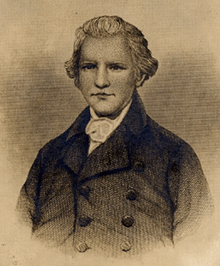William Osgoode
| William Osgoode | |
|---|---|
 | |
| Chief Justice of Upper Canada | |
|
In office 1792–1794 | |
| Preceded by | new title |
| Succeeded by | John Elmsley |
| Chief Justice of Lower Canada | |
|
In office 1794–1801 | |
| Preceded by | William Smith |
| Succeeded by | Henry Allcock |
| Personal details | |
| Born |
March 1754 London, England |
| Died |
January 17, 1824 (aged 69) London, England |
| Nationality | English |
| Residence |
York, Upper Canada London |
| Alma mater | Christ Church, Oxford |
| Occupation | barrister |
| Profession | Canadian and English jurist |
| Religion | Church of England |
William Osgoode (March 1754 – January 17, 1824) was the first Chief Justice of Upper Canada (now known as Ontario, Canada).
He was born William Osgood in London, England, in 1754 to William Osgood (died 1767).[1] His family was Methodist and John Wesley recounted on Sunday, 13 December 1767 that "I was desired to preach a funeral sermon for William Osgood. He came to London nearly thirty years ago, and from nothing increased more and more, till he was worth several thousands of pounds. He was a good man, and died in peace. Nevertheless, I believe his money was a great clog to him, and kept him in a poor, low state all his days, making no such advance as he might have done, either in holiness or happiness."[2]
He attended Christ Church, Oxford and was called to the bar in 1779. On December 31, 1791, he was appointed first Chief Justice of Upper Canada. Although he mainly sought the opinions of lawyers from England, Osgoode attempted to adapt the English civil law of the time to fit the needs of a developing colony. For example, he allowed justices of the peace to perform marriages when Anglican priests were not readily available. Osgoode's Judicature Act of 1794 established a system of district courts and a superior provincial court. During his term, legislation was also introduced to abolish slavery. Osgoode also served as a member of John Graves Simcoe's Executive Council for Upper Canada.
In 1794, he became Chief Justice of Lower Canada. Osgoode came into conflict with Governor Robert Prescott over an attempt to sort out the issue of land grants in the region. When Prescott was recalled, he came into conflict with Prescott's successor, Lieutenant Governor Robert Shore Milnes. In 1801, Osgoode resigned and returned to London. He became a member of the Royal Commission on the Courts of Law and help form what eventually led to the Uniformity of Process Act in 1832. Unmarried, Osgoode died in London in 1824 and is buried in St. Mary's Church, Harrow-on-the-Hill.
Osgoode Hall, the location of the Ontario Court of Appeal and the headquarters of the Law Society of Upper Canada, was named after him, as was Osgoode Hall Law School. In addition, the former Osgoode Township in Ontario also bears his name.[3]
_memorial%2C_St_Mary's%2C_Harrow_on_the_Hill%2C_2015_01.jpg)
References
- ↑ Mealing, S.R. (1987). "OSGOODE, WILLIAM". Dictionary of Canadian Biography. 6. Retrieved 12 May 2016.
- ↑ Wesley, John (1827). The Works of the Rev. John Wesley: The twelfth, thirteenth, fourteenth, fifteenth, sixteenth, seventeenth, and part of the eighteenth, numbers of his journal (First American ed.). J. & J. Harper. p. 234. Retrieved 12 May 2016.
- ↑ "Courageous settlers first located in Carleton back in 1818". Ottawa Citizen. Apr 28, 1953. pp. A20. Retrieved 2 December 2015.
- "Biography". Dictionnaire des parlementaires du Québec de 1792 à nos jours (in French). National Assembly of Quebec.
- Finding aid to the "William Osgoode collection" at the Archives of the Law Society of Upper Canada